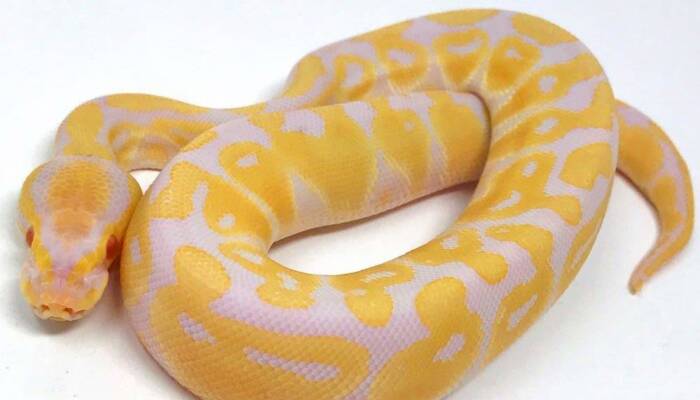Description
Banana Pinstripe Ball Python for Sale – Ranch of Exotic Breeds
Are you looking to add a unique and visually stunning snake to your collection? The Banana Pinstripe Ball Python is one of the most sought-after morphs in the reptile world, and at Ranch of Exotic Breeds, we’re excited to offer these beautiful creatures for sale. Known for their vibrant colors and distinctive patterns, Banana Pinstripe Ball Pythons are a perfect choice for both beginner and experienced reptile enthusiasts.
In this article, we’ll dive into everything you need to know about the Banana Pinstripe Ball python for sale, including its characteristics, care requirements, and why you should choose Ranch of Exotic Breeds Reptiles store for your next exotic pet purchase.
The Banana Pinstripe Ball python for sale is a mesmerizing morph that combines the bright yellow and lavender hues of the Banana gene with the sleek, striped pattern of the Pinstripe gene. These snakes are known for their docile temperament, making them ideal for handling and display. At Ranch of Exotic Breeds, we specialize in providing healthy, captive-bred Banana Pinstripe Ball Pythons that are ready to become a part of your family. Each snake is carefully raised and handled to ensure it is well-socialized and acclimated to its new home.
Why Choose a Banana Pinstripe Ball Python?
- Stunning Appearance: The Banana Pinstripe Ball Python is a visual masterpiece. Its bright yellow base color is accentuated by lavender undertones and clean, thin stripes that run along its body. No two Banana Pinstripe Ball Pythons are exactly alike, making each one a unique addition to your collection.
- Docile Temperament: Ball pythons are known for their calm and gentle nature, and the Banana Pinstripe morph is no exception. These snakes are easy to handle and rarely show aggression, making them perfect for both beginners and experienced keepers.
- Low Maintenance: Compared to other exotic pets, Banana Pinstripe Ball Pythons are relatively low-maintenance. They require a simple setup, a consistent feeding schedule, and minimal handling to thrive.
- Great for Breeding: If you’re interested in breeding, the Banana-Pinstripe Ball Python is a fantastic choice. Its unique genetics can produce a variety of stunning morphs when paired with other ball python genes.
Care Requirements for Banana-Pinstripe Ball Pythons
To ensure your Banana Pinstripe Ball Python thrives, it’s important to provide the proper care and environment. Here’s a quick guide to help you get started:
1. Enclosure Setup
- Tank Size: A 20-30 gallon tank is suitable for an adult Banana Pinstripe Ball Python.
- Substrate: Use coconut fiber, cypress mulch, or aspen bedding to maintain humidity.
- Temperature: Maintain a gradient of 78-80°F on the cool side and 88-92°F on the warm side.
- Humidity: Keep humidity levels between 50-60%, with a slight increase during shedding.
2. Feeding
- Diet: Feed your snake appropriately sized frozen-thawed rodents (mice or rats) every 7-10 days.
- Water: Provide a clean water dish large enough for your snake to soak in.
3. Handling
- Handle your Banana-Pinstripe Ball Python gently and consistently to build trust. Avoid handling during shedding or immediately after feeding.
4. Health
- Regularly check for signs of illness, such as lethargy, loss of appetite, or abnormal shedding. Schedule annual check-ups with a reptile veterinarian.
Why Buy from Ranch of Exotic Breeds?
At Ranch of Exotic Breeds, we pride ourselves on providing high-quality, healthy, and well-socialized exotic pets. Here’s why you should choose us for your Banana-Pinstripe Ball Python purchase:
- Captive-Bred Snakes: All our Banana-Pinstripe Ball Pythons are bred in captivity, ensuring they are healthy and free from parasites.
- Expert Care: Our team of reptile experts ensures that each snake is raised in optimal conditions and receives proper handling and care.
- Customer Support: We offer lifetime support for all our customers, so you can reach out to us with any questions or concerns about your new pet.
- Shipping: We provide safe and reliable shipping options to ensure your snake arrives healthy and stress-free.
FAQs About Banana-Pinstripe Ball Pythons
1. What is a Banana-Pinstripe Ball Python?
A Banana Pinstripe Ball Python is a morph that combines the Banana gene (known for its bright yellow and lavender colors) with the Pinstripe gene (characterized by thin, clean stripes).
2. Are Banana-Pinstripe Ball Pythons good for beginners?
Yes! Their docile nature and low-maintenance care requirements make them an excellent choice for first-time snake owners.
3. How big do Banana-Pinstripe Ball Pythons get?
Adult Banana-Pinstripe Ball Pythons typically reach 3-5 feet in length, with females being slightly larger than males.
4. What do Banana-Pinstripe Ball Pythons eat?
They primarily eat frozen-thawed rodents, such as mice or rats, depending on their size.
5. How long do Banana-Pinstripe Ball Pythons live?
With proper care, these snakes can live for 20-30 years in captivity.
6. Can I breed Banana-Pinstripe Ball Pythons?
Absolutely! Their unique genetics make them a popular choice for breeding projects.
7. Do you ship Banana-Pinstripe Ball Pythons?
Yes, we offer safe and reliable shipping options to customers across the United States.
8. What is the price of a Banana-Pinstripe Ball Python?
Prices vary depending on age, size, and genetics. Contact us for current pricing and availability.
Bring Home Your Banana-Pinstripe Ball Python Today!
The Banana Pinstripe Ball Python is a true gem in the world of exotic pets. Its stunning appearance, gentle temperament, and ease of care make it a favorite among reptile enthusiasts. At Ranch of Exotic Breeds, we’re committed to providing you with the highest quality Banana Pinstripe Ball Pythons, at our Reptiles store along with the support and resources you need to care for your new pet.
Ready to make this beautiful Snakes for sale a part of your life? Visit our website or contact us today to check availability and reserve your pinstripe ball pythons for sale. Don’t miss out on the opportunity to own one of the most captivating reptiles in the world!





Reviews
There are no reviews yet.